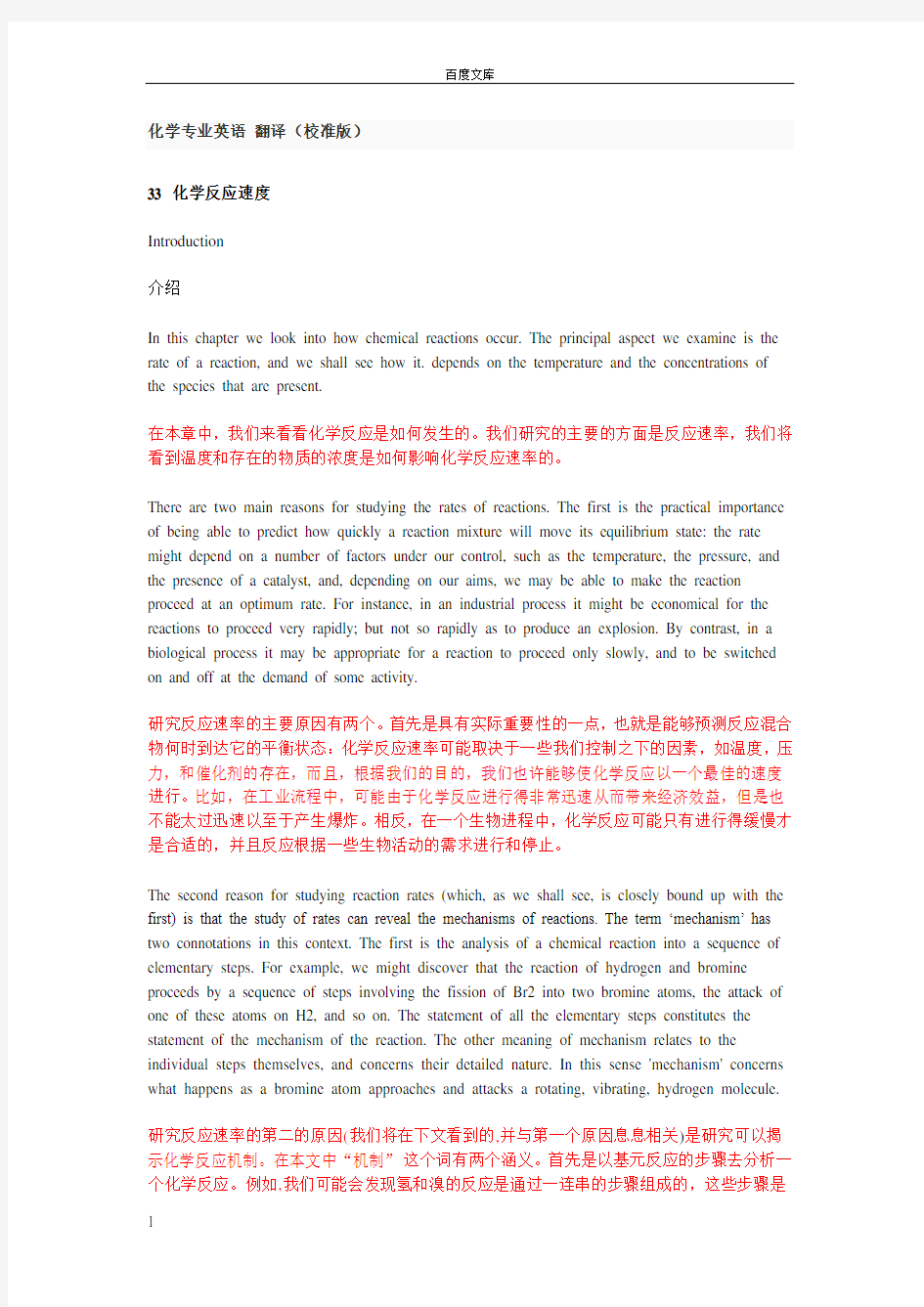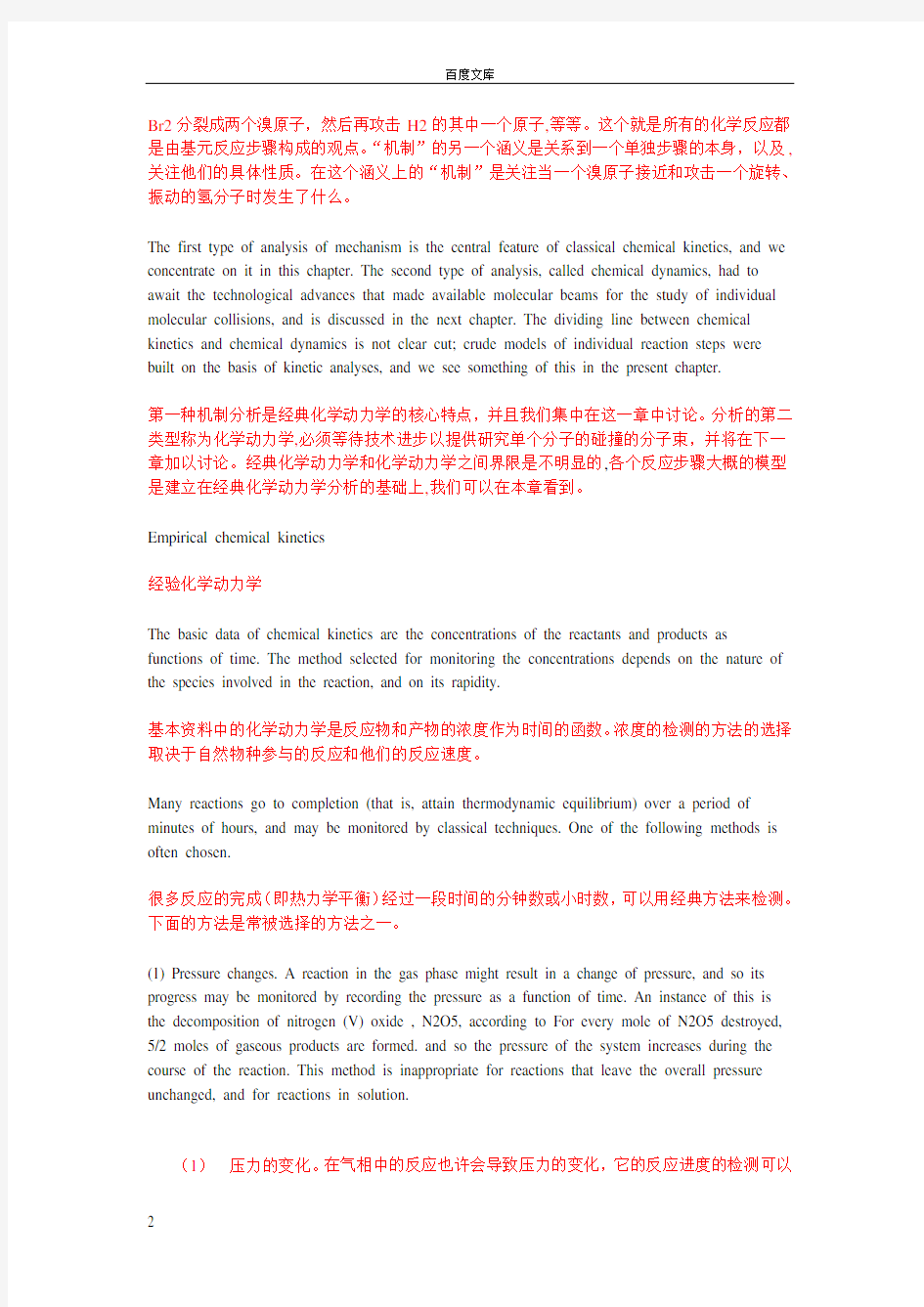化学专业英语翻译33化学反应速度


化学专业英语翻译(校准版)
33 化学反应速度
Introduction
介绍
In this chapter we look into how chemical reactions occur. The principal aspect we examine is the rate of a reaction, and we shall see how it. depends on the temperature and the concentrations of the species that are present.
在本章中,我们来看看化学反应是如何发生的。我们研究的主要的方面是反应速率,我们将看到温度和存在的物质的浓度是如何影响化学反应速率的。
There are two main reasons for studying the rates of reactions. The first is the practical importance of being able to predict how quickly a reaction mixture will move its equilibrium state: the rate might depend on a number of factors under our control, such as the temperature, the pressure, and the presence of a catalyst, and, depending on our aims, we may be able to make the reaction proceed at an optimum rate. For instance, in an industrial process it might be economical for the reactions to proceed very rapidly; but not so rapidly as to produce an explosion. By contrast, in a biological process it may be appropriate for a reaction to proceed only slowly, and to be switched on and off at the demand of some activity.
研究反应速率的主要原因有两个。首先是具有实际重要性的一点,也就是能够预测反应混合物何时到达它的平衡状态:化学反应速率可能取决于一些我们控制之下的因素,如温度,压力,和催化剂的存在,而且,根据我们的目的,我们也许能够使化学反应以一个最佳的速度进行。比如,在工业流程中,可能由于化学反应进行得非常迅速从而带来经济效益,但是也不能太过迅速以至于产生爆炸。相反,在一个生物进程中,化学反应可能只有进行得缓慢才是合适的,并且反应根据一些生物活动的需求进行和停止。
The second reason for studying reaction rates (which, as we shall see, is closely bound up with the first) is that the study of rates can reveal the mechanisms of reactions. The term ‘mechanism’ has two connotations in this context. The first is the analysis of a chemical reaction into a sequence of elementary steps. For example, we might discover that the reaction of hydrogen and bromine proceeds by a sequence of steps involving the fission of Br2 into two bromine atoms, the attack of one of these atoms on H2, and so on. The statement of all the elementary steps constitutes the statement of the mechanism of the reaction. The other meaning of mechanism relates to the individual steps themselves, and concerns their detailed nature. In this sense 'mechanism' concerns what happens as a bromine atom approaches and attacks a rotating, vibrating, hydrogen molecule.
研究反应速率的第二的原因(我们将在下文看到的,并与第一个原因息息相关)是研究可以揭示化学反应机制。在本文中“机制”这个词有两个涵义。首先是以基元反应的步骤去分析一个化学反应。例如,我们可能会发现氢和溴的反应是通过一连串的步骤组成的,这些步骤是
Br2分裂成两个溴原子,然后再攻击H2的其中一个原子,等等。这个就是所有的化学反应都是由基元反应步骤构成的观点。“机制”的另一个涵义是关系到一个单独步骤的本身,以及,关注他们的具体性质。在这个涵义上的“机制”是关注当一个溴原子接近和攻击一个旋转、振动的氢分子时发生了什么。
The first type of analysis of mechanism is the central feature of classical chemical kinetics, and we concentrate on it in this chapter. The second type of analysis, called chemical dynamics, had to await the technological advances that made available molecular beams for the study of individual molecular collisions, and is discussed in the next chapter. The dividing line between chemical kinetics and chemical dynamics is not clear cut; crude models of individual reaction steps were built on the basis of kinetic analyses, and we see something of this in the present chapter.
第一种机制分析是经典化学动力学的核心特点,并且我们集中在这一章中讨论。分析的第二类型称为化学动力学,必须等待技术进步以提供研究单个分子的碰撞的分子束,并将在下一章加以讨论。经典化学动力学和化学动力学之间界限是不明显的,各个反应步骤大概的模型是建立在经典化学动力学分析的基础上,我们可以在本章看到。
Empirical chemical kinetics
经验化学动力学
The basic data of chemical kinetics are the concentrations of the reactants and products as functions of time. The method selected for monitoring the concentrations depends on the nature of the species involved in the reaction, and on its rapidity.
基本资料中的化学动力学是反应物和产物的浓度作为时间的函数。浓度的检测的方法的选择取决于自然物种参与的反应和他们的反应速度。
Many reactions go to completion (that is, attain thermodynamic equilibrium) over a period of minutes of hours, and may be monitored by classical techniques. One of the following methods is often chosen.
很多反应的完成(即热力学平衡)经过一段时间的分钟数或小时数,可以用经典方法来检测。下面的方法是常被选择的方法之一。
(1) Pressure changes. A reaction in the gas phase might result in a change of pressure, and so its progress may be monitored by recording the pressure as a function of time. An instance of this is the decomposition of nitrogen (V) oxide , N2O5, according to For every mole of N2O5 destroyed, 5/2 moles of gaseous products are formed. and so the pressure of the system increases during the course of the reaction. This method is inappropriate for reactions that leave the overall pressure unchanged, and for reactions in solution.
(1)压力的变化。在气相中的反应也许会导致压力的变化,它的反应进度的检测可以
通过记录压力作为时间的函数来进行。这是一个实例:五氧化二氮的分解,根据:
(五氧化二氮的分解方程式)每反应1摩尔五氧化二氮,便有摩尔气体生成,所以
在反应过程中系统的压力会增加。这个方法不适合总体压力不变和在溶液中的反
应。
(2) Spectroscopy. A technique that is available even when no pressure change occurs is the spectroscopic analysis of the mixture. For instance, the reaction can be followed by monitoring the intensity of absorption of visible light by the bromine.
(2)光谱研究。光谱研究是一个即使没有压力的变化发生也依然有效的对混合物进行光谱分析的方法。例如:反应可以通过检测溴在可见光中强度的吸收被追踪。
(3)Polarimetrv. When the optical activity of a mixture changes in the course of reaction, it can be monitored by measuring the angle of optical rotation. This is a historically important method because its application to the hydrolysis of sucrose was the first significant study of the rate of a reaction (by Wilhelmy in 1850).
(3)旋光计。当混合物的光学活动在反应过程中变化时,它可以通过测量光学的旋转角度的方法被检测。从历史上看这是一个重要的方法因为它对蔗糖水解的应用程序是对反应速率的第一个显著的研究。(威廉米,1850年)
(4) Electrochemical methods. When a reaction changes the number or nature of ions present in a solution, its course may be followed by monitoring the conductivity of the solution. One very important class of reactions consists of those occurring at electrodes, and we examine them in Chapter 3D.
(4)电化学方法。当离子的数量和性质在溶液中呈现反应变化时,它的进程可以通过检测溶液的电导率从而被跟踪。那些由发生在电极上的一类非常重要的反应我们将在30章在学习。
(5) Miscellaneous methods. Other methods of determining composition include mass spectrometry and chromatography. In order to employ these techniques, a small amount of the reaction mixture is bled from the reacting system at a series of times after the initiation of the reaction, and then analyzed. There are three main ways of applying these analytical techniques.
(5)其他方法。其他的可以确定组成的方法包括质量光谱法和色谱法。为了采用这些技术,少量的反应混合物在一系列反应体系的时间减少后开始反应,然后分析。
应用这些分析方法有三种主要的方法。
(1)Real time analysis. In this method the composition of the system is analyzed while the reaction is in progress.
(1)实时分析。在该方法中系统的构成,分析了反应的进程。
(2) Quenching. In this method the reaction is frozen after it has been allowed to proceed for a certain time, and then the composition is analysed by any suitable technique. The quenching can normally be achieved by lowering the temperature suddenly . but this is suitable only for reactions that are slow enough for there to be little reaction during the time it takes to cool the mixture.
(2)淬火法。在这种方法中反应是被冷却一段时间后才被允许继续进行的,然后可以通过任何合适的方法分析混合物的组成。淬火法通常可以通过突然降低温度来实现,但是这仅仅适用于那些反应慢得足以让在冷却混合物所花费的时间期间只有一点点的反应的反应。
(3) Flow method. In this method, solutions of the reagents are mixed as they flow together into a chamber, Fig 4. The reaction continues as the thoroughly mixed solutions flow through the outlet tube, and observation of the composition at different positions along the tube (for example, by spectroscopy) is equivalent to observing the reaction mixture at different times after mixing. Reactions that are complete within a few milliseconds can he observed with this technique, but its principal disadvantage is that large volumes of solutions are necessary. The method has been improved, and a modification . the stopped-flow method, is in wide use.
(3)流动法。在这种方法中,将试剂溶液流动到一个腔中的方法将其混合起来,如图4。反应持续进行直到彻底混合溶液流出排水管。然后沿着管道观察不同位置的成分(例如,通过光谱)就相当于观察反应物在混合后的不同时期。在几毫秒内完成的反应也可以通过这个技术观察。但它的主要缺点是必须进行大批量的检测。但该方法已得到改善,停流的方法已被广泛使用。
The rates of chemical reactions have been found to depend very strongly on the temperature, and many follow the Arrhenius rate law, that the rate is proportional to exp (-Ea/RT), where Ea is the activation energy of the reaction. The implication of this observation for experimental studies is that the temperature of the reaction mixture must be held as constant as possible throughout the course of the reaction; otherwise the observed reaction rate will be a meaningless average of rates at different temperatures. This requirement puts severe demands on the design of the experiment. Gas phase reactions, for instance, are often carried out in a vessel held in contact with a substantial block of metal, and liquid phase reactions, including flow reactions . must be carried out in an efficient thermostat.
人们发现化学反应速率受温度很大影响,并且大多数都遵循阿伦尼乌斯定律、即速率正比于(-Ea / RT),式中Ea是反应活化能。这就意味着这个实验研究的观测要尽可能的在整个过程中保持反应混合物的温度恒定。否则,观察到的反应速率将会是一个毫无意义的在不同温度下的平均速率。这样就对实验设计提出了严格的要求。例如,气相反应中,通常是在一个容器中用大量的金属块安装触媒;在液相反应中,包括流动的反应,必须安装有效的温控器。
The general result of these experiments is that the rates of chemical reactions depend on the composition of the reaction mixture, and most depend exponentially on the temperature. The next
few sections look at these observations in more detail.
通常这些实验结果是化学反应速率取决于反应混合物的组成,并且与温度有很大关系。接下来的几节中可以观察到更多的细节。
The rates of reactions
反应的速率
Suppose the reaction of interest is of the form
假设反应底形式是
A +
B ——→products, P
A+ B——→产品、P
and that the concentrations of the species A, B, and P are [A[, [B], and [P] respectively. The rate of the reaction can be expressed as the rate of change of the concentration of any of the species. Thus the rate of formation of product is d[P]/dt and the rate of destruction of A. is d[A]/dt. In the present case
物质A,B,和P的浓度分别是[A],[B]和[P]。任何物种的浓度的变化率可以表示为反应速率。所以产物生成的速率是d[P] / dt以及A的反应速率是d [A] / dt。在目前情况下
d[P]/dt = -d[A]/dt = -d[B]/dt
because a B molecule must be destroyed for every A molecule destroyed, and in the process a P molecule is formed. Any of these derivatives can serve as the definition of the rate of reaction, the only care needed is to keep the signs correct.
由于反应一个B分子就必须反应一个A分子,并且在此过程中生成一个P分子。任何这些衍生物都可以作为定义的反应速率的物质。值得注意的事,需要的是保证其标志是正确的。
